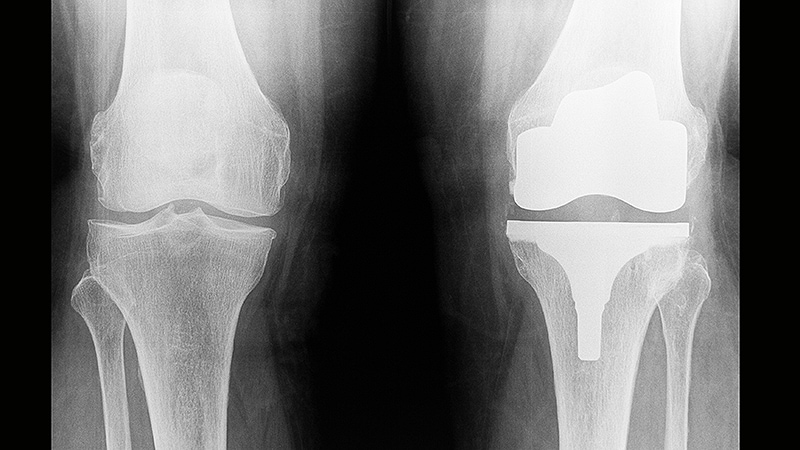CHICAGO — Posterior-stabilized (PS) bearings used in total knee arthroplasty (TKA) may increase the risk of revision compared with bearings of other design, new data suggest.
That possiblity has previously been reported in studies outside the United States, and now an analysis of more than 300,000 cases in the American Joint Replacement Registry (AJRR) suggests it’s the case in the US as well.

Dr Ryland Kagan
Principal investigator Ryland Kagan, MD, assistant professor of orthopedic surgery at Oregon Health and Science University (OHSU) in Portland, told Medscape Medical News, “What’s unique about our experience in the US is our overall high use of PS implants.”
More than half of TKAs in the US use the PS bearings; in comparison, in Australia and European countries, PS use is closer to 20%, he said. Because of this disparity, previous studies have not been seen as generalizable to the US, he said.
Researchers used AJRR data from 2012–2019 and identified all primary TKA procedures performed during that period. Cases were linked to supplemental Centers for Medicare & Medicaid Services data to find revision procedures that may not have been included in the AJRR database.
Jamil Kendall, MD, an orthopedic resident at OHSU, was first author on the study. The team evaluated patient demographics, polyethylene characteristics, procedure dates, and cause for revision in the 305,279 cases.
Of those cases in which implant characteristics were reported, 161,486 (52.9%) patients received PS bearings, and 143,793 (47.1%) received minimally stabilized bearings.
The researchers compared three minimally stabilized implants (cruciate retaining [CR], anterior stabilized [AS], or pivot bearing designs) with each other for risk and then compared minimally stabilized options as a group with the PS bearings.
They found no significant differences among the three minimally stabilized options.
But revision risk was higher when they compared the minimally stabilized implants with the PS bearing implants. Use of PS bearings had a hazard ratio (HR) of 1.25 (95% CI, 1.2 – 1.3; P < .0001) for all-cause revision and an HR of 1.18 (95% CI, 1.0 – 1.4; P = .02) for infection.
Among the patients with minimally stabilized bearings, 1693 (1.2%) underwent revision for any cause, and 334 (0.2%) underwent revision for infection. For patients with PS bearings, 2406 (1.5%) underwent revision for any cause, and 446 (0.3%) underwent revision for infection.
Even a Small Difference Significant
Kagan said, “The difference isn’t dramatic, but when you think of the total number of total knee arthroplasties done, you’re talking about millions of procedures. Even with a small increased risk, you’re going to see a large influence for a population.”
Richard Lynn Illgen, MD, director of the University of Wisconsin-Madison Joint Replacement Program, told Medscape Medical News this work identifies a trend, but he pointed out that registry-based studies have important limitations.
“They cannot establish causality,” he said. “There are many potential confounding variables and potential selection biases that could affect the study. Specifically, the study did not control for degree of deformity or medical comorbidities. Although some surgeons routinely use PS designs for all primary TKAs, others use PS designs for patients with more severe deformities. It is possible that PS designs were used more frequently in patients with a greater degree of deformity, and this could introduce a selection bias.”
He added that no data were included to enable stratification of groups according to medical comorbidities.
“It is possible that selection bias exists comparing the relative degree of medical comorbidities between patients in the PS TKA and minimally constrained TKA groups,” Illgen said.
He said further prospective, randomized studies are needed to eliminate selection bias and to better determine whether the observed pattern of increased risk of revision holds up compared with the minimally supported versions.
The authors acknowledged those limitations, but Kagan said the high percentage of PS procedures in the US helps mitigate potential bias.
Illgen serves as a consultant and developer for Stryker, is chair of the AAOS AJRR Research Projects Subcommittee and is a member of the AJRR Steering Committee. Kagan receives research support from KCI, Ortho Development Corporation, and Smith & Nephew, where he is also a paid consultant. Kendall reports no relevant financial relationships. Another co-author of the study is a paid consultant for 3M, Heraeus, Immunis, Smith & Nephew, Zimmer Biomet, and Total Joint Orthopedics and has stock or stock options in Joint Development, LLC.
American Academy of Orthopedic Surgeons (AAOS) 2022 Annual Meeting: Poster P0092. Presented March 2022].
Marcia Frellick is a freelance journalist based in Chicago. She has previously written for the Chicago Tribune, Science News, and Nurse.com, and was an editor at the Chicago Sun-Times, the Cincinnati Enquirer, and the St. Cloud (Minnesota) Times. Follow her on Twitter at @mfrellick
For more news, follow Medscape on Facebook, Twitter, Instagram, and YouTube.

